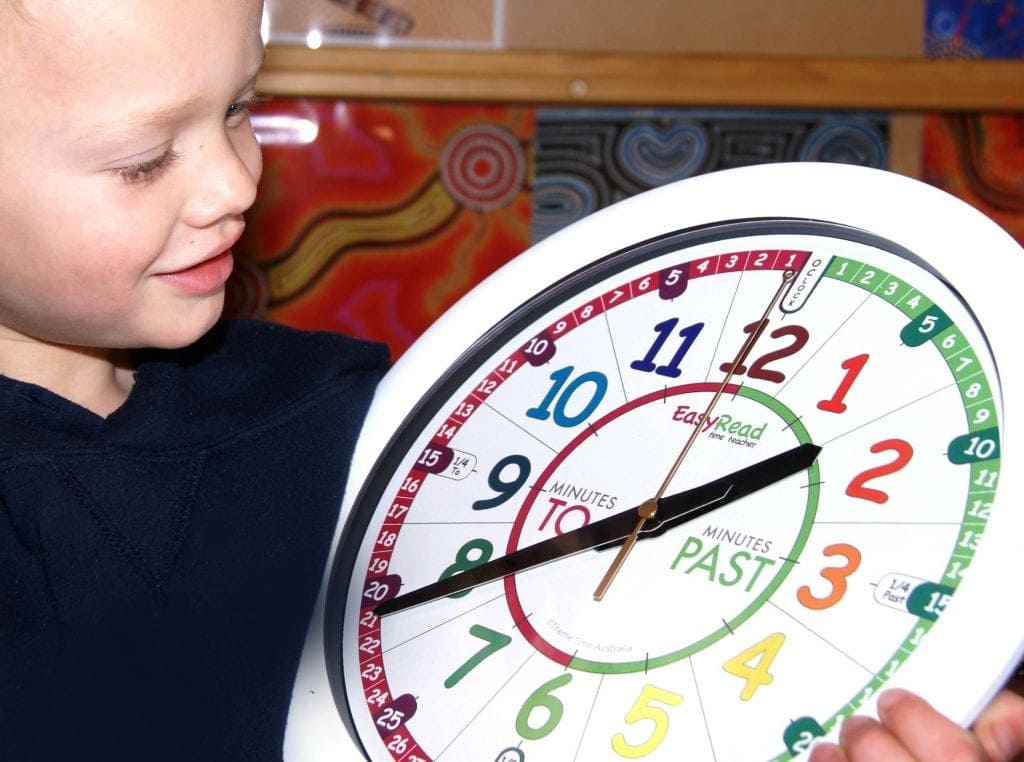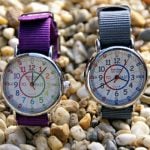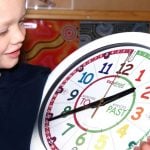Teaching How to Tell the Time…Teaching Kids Matters!
At first glance knowing how to tell the time is relatively simple- a cognitive task many habitually complete several times daily without much thought, but if we delve a little deeper it is not surprising that reading clocks is one of the most multifaceted symbol systems that children encounter. From distinguishing between night and day to negotiating transportation timetables, scheduling daily activities and reflecting on past events, reading the time is an essential life-skill, but teaching how to tell the time may not come easily. So what can teachers and parents do to facilitate our young clock readers? Here are 5 fun yet practical tips that will have the kids rocking around the clock in no time:
1. Play, Play, Play: Developing Language and Meaning
Unlike other attributes of measurement, time is an abstract concept that cannot be perceived through touch. It needs to be experienced. Children from an early age can devise their own understandings of time duration and ambiguous terms such as ‘seconds’, ‘minutes’ and ‘hours’ simply by participating in play and song. Clapping, skipping, hopping, drawing, cleaning their room for nominated periods of time, building and interacting with water and sand timers, swinging pendulums, sundials and observing the movement of shadows and light are examples of children being immersed in time in their natural environments. Verbalising daily activities such as, ‘It will be 5 minutes until dinnertime, that’s about the same amount of time as a Peppa Pig show’, reinforce time specific vocabulary and give the words meaning.
The prepositions ‘before’, ‘after’, ‘past’ and ‘to’ also play a vital role in clock reading. Prepositions are best taught with physically moving objects or oneself and discussing an object’s position and movement in relation to the remaining items. Races, obstacle courses and find the treasure games help the learning of prepositions. Children who have an understanding of these terms find it easier to read times where the minute hand has moved beyond o’clock.
2. Sequencing and Pattern Making: Facilitating The Conceptualisation of Time
Once children become aware of the concept of time, they quickly develop an interest in ‘when’, ‘how long’ and ‘what time’ events occur. Creating a family or classroom daily routine chart helps kids to order their days, discover the 12 and 24 hour cycles of a clock and pinpoint patterns in days, weeks, months and years.
3. Number sense
Counting, ordering and identifying numbers to 60 is important for reading times beyond o’clock, however in order for this to be done with speed, skip counting by 5s or better yet the automatic recall of multiples of 5 is essential. Times table songs make for fun learning and several great ones are available.
Educational Resources For Prep Students With Literacy And Numeracy Issues
4. Investigating The Face of a Clock
With some experience of time duration, time specific vocabulary and number sense it is time to break down the clock and explore each one of its features and functions.
The Hands:

Generally there are 3 hands on a clock, namely the second, minute and hour hands. Each has its own length and speed which influence the other hands. Watching and manipulating clocks permits children to explore these relationships; discovering there are 60 seconds in a minute and 60 minutes in 1 hour. Many children find it challenging to recall which hand is which so utilising clocks that overemphasise hand size or distinguish hands via colour make useful tools.
The Numerals:
One of the most difficult concepts to grasp when reading an analogue clock is the double meaning of the numerals 1-12. For the hour hand we read 1 for 1, 2 for 2 and so on, yet for a minute hand we read 5 minute intervals-5 for 1 and 10 for 2. An easy and fun way to explain this fact to children is explaining that the numerals 1-12 have secret identities when the minute and second hands are concerned. For instance, normal everyday 2 becomes Terrific 10 when the minute or second hand is pointing to it.
12… The Most Important Landmark:
Despite 3, 6 and 9 being valuable numerals on a dial, Williams. R (2004), states that on a clock the numeral 12 carries many associations and thus is the key landmark. According to Metelerkamp (2013), children who use 12 as a reference point and have a sound knowledge of its various roles acquire stronger mental images of the dial and are more confident time readers.
Tool to Test if Your Child is Ready for Prep
5. Selecting Powerful Learning Tools
Learning resources can play a vital part in learning and consolidating skills required for telling the time but what should we look for?
- A clock that can be manipulated with hand differentiation (either an overemphasis on size or colour), secret identities revealed and no distracting background pictures.
- Paper plates to create clocks and their features.
- Simple puzzles to practise placing the numerals in the correct locations.
- Digital clock for reinforcing and comparing minutes.
- Quality Children’s Books such as: Clocks and More Clocks by Pat Hutchins, Telling Time with Big Mama Cat by Dan Harper and Tuesday by David Wiesner.
- A watch to practise reading and monitoring the time naturally throughout the day.
It is imperative that time is dedicated to helping children develop their working memories, allowing them to build stronger foundations for identifying, comparing, estimating and governing passages of time. Through multiple experiences and hands-on activities, children will be equipped with the skills necessary for reading the clock and for daily life.
Krystal Warburton is a primary school teacher and founder of Sweet Elephants, bringing versatile and long-lasting educational toys, including these great clocks to teach children to tell the time, to your homes and schools to be treasured by children for many years to come. http://sweetelephants.com.au
This article was published in Issue 12 of our print magazine, October/November 2015.



